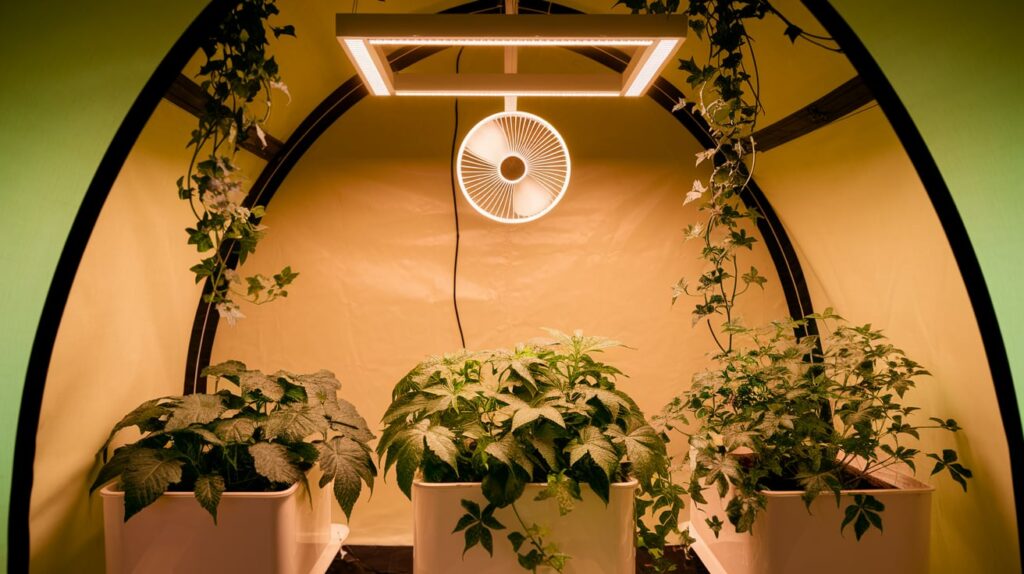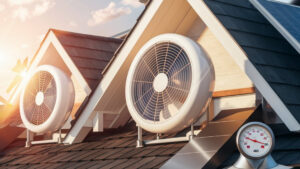Are you struggling to find the perfect way to hang a fan in your grow tent? You’re not alone.
Many indoor gardeners face this challenge as they strive to create the ideal environment for their plants. A well-placed fan is crucial for maintaining air circulation, controlling temperature, and ensuring your plants thrive. But how do you do it without causing damage or compromising the setup of your tent?
This guide will walk you through the simple steps to hang a fan in your grow tent, helping you to maximize growth and efficiency. Stick with us to discover how you can transform your grow space into a plant paradise with just a few tweaks. Ready to elevate your gardening game? Let’s get started!
Choosing The Right Fan
Positioning a fan in a grow tent ensures even air distribution. Secure it at the top for optimal airflow. Adjust the angle to cover all plants efficiently.
Choosing the right fan for your grow tent is crucial. It impacts the air circulation, temperature, and overall health of your plants. But how do you decide which fan is best suited for your needs? Let’s break it down into manageable steps.
Types Of Fans
There are several fan types you can consider for your grow tent. Oscillating fans are popular because they distribute air evenly across your plants, preventing hotspots. Clip-on fans are compact and easy to position, making them ideal for smaller tents. Inline fans are powerful and often used for ventilation systems to control humidity and temperature efficiently. Think about the layout of your tent and your specific needs before making a choice.
Size And Power Considerations
Size matters when choosing a fan for your grow tent. A fan that’s too small might fail to circulate enough air, while a fan that’s too large could overwhelm your plants. Consider the dimensions of your tent. If it’s a small tent, a compact fan might do the trick. For larger tents, you may need multiple fans or a more powerful option.
Power is another crucial factor. Measure the cubic feet per minute (CFM) rating of the fan, which indicates its airflow capacity. Ensure the CFM aligns with the size of your tent to maintain optimal conditions.
Have you ever installed a fan only to find it underperforming or overpowering your setup? Finding the balance is key to a thriving grow environment.
Think about the time and effort you put into nurturing your plants. The right fan can make all the difference in ensuring they flourish.
Choosing the right fan is not just about the specs; it’s about understanding your unique needs and the environment you’re cultivating.
Placement Strategies
Hanging a fan in a grow tent needs good placement strategies. Proper fan placement ensures healthy plant growth. It helps maintain air circulation and temperature. This section covers key strategies for optimal fan placement.
Optimal Locations
Position the fan to promote even air distribution. Place it near the top of the tent. This helps push warm air down. Avoid direct airflow on plants. It can damage leaves and stems. Use oscillating fans for better coverage.
Corner placement can maximize space. It also reduces clutter. Ensure the fan is stable and secure. This prevents accidents. A stable fan contributes to a safer growing environment.
Height Adjustments
Adjust the fan height for effective air circulation. Hang it high for larger tents. This helps distribute air evenly. Lower the fan for smaller tents. It ensures proper airflow around all plants.
Consider plant height when adjusting. Taller plants need airflow at the canopy level. Adjust the fan as plants grow. This maintains consistent air movement. Consistency is key for plant health.
Mounting Techniques
Mounting techniques are crucial for efficient fan placement in grow tents. Properly hung fans ensure optimal air circulation. Effective mounting can enhance plant growth and health.
Using Clips And Hooks
Clips and hooks are easy options for mounting fans. They allow flexible positioning without complicated tools. Choose clips that fit tent poles securely. Hooks can hang fans from the tent’s ceiling. Make sure they can hold the fan’s weight. Check regularly for stability.
Secure Fastening Methods
Secure fastening is important for safety. Zip ties and ropes are sturdy options. Use heavy-duty zip ties for strong hold. Position them tightly around the fan and pole. Ropes offer adjustable length and strength. Knot them properly to avoid slipping. Inspect connections often to prevent accidents.
Safety Measures
Ensuring safety while hanging a fan in a grow tent is crucial. Proper precautions protect both plants and people. This section outlines essential safety measures for installing fans safely.
Electrical Safety
Check the fan’s wiring before installation. Ensure all wires are intact, without damage or wear. Use a properly grounded outlet to avoid electrical hazards. Keep electrical cords away from water and moisture. Position the fan away from any water sources inside the tent.
Use extension cords with the right voltage rating. Ensure they are suitable for the fan’s power requirements. Avoid overloading circuits by connecting too many devices. Regularly inspect the cords for any signs of damage.
Avoiding Overheating
Fans can overheat if they run continuously. Set timers to control operation times. Allow the fan to rest periodically to prevent overheating. Check the fan’s temperature during operation. If it feels hot, switch it off immediately.
Ensure adequate ventilation in the grow tent. Proper air circulation helps cool the fan. Keep the tent environment at a stable temperature. This minimizes the risk of overheating and maintains optimal conditions for plants.
Improving Air Circulation
Enhancing air circulation in a grow tent involves hanging a fan properly. Secure the fan at a suitable height for optimal airflow. Position it to cover all areas, ensuring fresh air reaches every plant.
Improving air circulation in your grow tent is crucial for the health and productivity of your plants. Proper air movement ensures that your plants get the necessary carbon dioxide and prevents hot spots that could stress your plants. With the right setup, you can create an environment where your plants thrive, leading to a bountiful harvest.
Creating Effective Airflow
Your goal is to mimic the natural outdoor breeze inside your grow tent. Hang your fan so it can gently rustle the leaves of all your plants. This not only strengthens the stems but also helps in the even distribution of CO2.
Position the fan slightly above the canopy level and angle it downwards. This setup helps in pushing stale air out and drawing fresh air in. Remember, the fan should circulate the air, not blast it; your plants shouldn’t be swaying like they’re in a hurricane.
Think about where you hang your fan. If your grow tent is in a corner, place the fan in the opposite direction to promote cross-ventilation. This strategy ensures no area in your grow tent remains stagnant.
Balancing Humidity Levels
Humidity plays a vital role in plant health. Too much moisture can lead to mold, while too little can stunt growth. The fan helps in maintaining a balanced humidity level by continuously moving air around.
Monitor your grow tent’s humidity levels regularly. A hygrometer can be a handy tool for this purpose. Adjust the fan speed based on the readings, ensuring your plants are in the sweet spot for growth.
Have you ever noticed how a simple fan can make a room feel cooler? The same principle applies in your grow tent. Proper air circulation can prevent heat buildup, creating a more stable environment for your plants.
By focusing on effective airflow and balanced humidity, you’re setting up your grow tent for success. Imagine the joy of watching your plants flourish, knowing that your thoughtful fan placement played a big part.
Troubleshooting Common Issues
Hanging a fan in a grow tent can improve air circulation. But, it often comes with challenges. Many growers face issues like noise and vibrations. These problems can affect plant growth and disrupt your peace. Understanding these issues helps you solve them easily. Let’s explore some common problems and effective solutions.
Noise Reduction Tips
Fans can be noisy and disturbing. The key is to isolate the noise source. Use rubber mounts to reduce contact noise. Check for loose parts on the fan. Tighten any screws or bolts. Try placing the fan on a soft surface. This can absorb some of the noise.
Consider using a speed controller. Reducing fan speed can decrease noise levels. Opt for a high-quality, quiet fan model. This can make a big difference in noise reduction.
Vibration Management
Vibrations can shake your grow tent. This might harm your plants. To manage vibrations, hang the fan with bungee cords. They act as shock absorbers. Ensure the fan is balanced. An unbalanced fan can cause more vibrations.
Check the fan blades for debris. Clean them regularly to keep balance. Use foam pads under the fan. This helps in reducing vibrations. Vibration dampeners can also be a good investment. They provide extra stability to your fan setup.
Maintenance And Care
Maintaining and caring for your fan in a grow tent is vital. Regular upkeep ensures optimal performance and extends the fan’s lifespan. Neglecting maintenance may lead to reduced airflow and potential plant damage. Keeping the fan clean and checking its performance regularly will enhance your grow tent’s environment.
Regular Cleaning
Dust and debris accumulate on fan blades and surfaces over time. This buildup can reduce airflow and efficiency. Clean the fan blades and housing every few weeks. Use a soft cloth or brush to wipe away dust. For thorough cleaning, you can also use mild soap and water. Ensure the fan is unplugged before cleaning to prevent accidents.
Performance Checks
Regular checks ensure your fan operates at its best. Listen for unusual noises or vibrations. These can indicate loose parts or motor issues. Test different settings to confirm the fan adjusts speeds properly. Check the power cord for any signs of wear or damage. Replace parts as needed to maintain efficiency and safety.

Frequently Asked Questions
Where Do You Put The Fan In A Grow Tent?
Place the fan at the top or side of the grow tent for optimal airflow. Ensure air circulation reaches all plants. Adjust the fan angle to prevent direct wind on plants, reducing stress. Positioning near the exhaust helps remove heat and humidity effectively.
How Do You Hang A Fan In A Tent?
Use a clip-on tent fan for easy attachment. Secure it to tent poles or loops. Ensure the fan is stable and won’t fall. Check the power source, like batteries or USB, for convenience. Adjust the fan’s direction for optimal airflow.
Always follow the manufacturer’s instructions for safe installation.
Should I Run My Exhaust Fan In My Grow Tent All The Time?
Running the exhaust fan continuously in a grow tent ensures proper ventilation and temperature control. It helps prevent mold, pests, and heat buildup. Adjust the fan speed based on plant needs and environmental conditions. Consistent airflow is crucial for healthy plant growth and maintaining optimal conditions.
Should The Fan Be Inside Or Outside The Grow Tent?
Place the fan inside the grow tent for optimal air circulation. This setup helps maintain temperature and humidity. Ensure proper airflow by positioning the fan near the top. This helps remove hot air and provides fresh air to plants.
Conclusion
Hanging a fan in your grow tent boosts plant health. It ensures proper airflow and temperature control. Easy steps help you achieve this setup. Remember to choose the right fan size. Securely mount it for stability and safety. Avoid blocking light or air paths.
Regularly check and adjust the fan’s position. This keeps your plants thriving. With the right approach, your grow tent becomes more efficient. Your plants will thank you for it. Keep these tips handy for a successful gardening experience. Happy growing!








